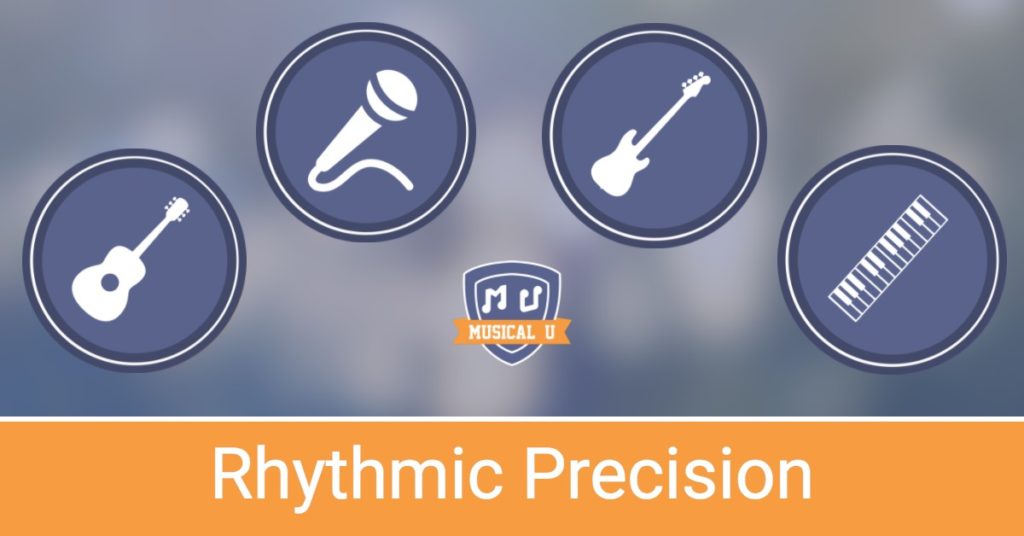Once you can pretty reliably play “the right notes”, what sets a good musician apart from a great one? Without a doubt, one crucial skill is rhythmic precision. A sloppy or unreliable sense of the beat will quickly distinguish an amateur from a pro.
In this month’s Instrument Packs our Resident Pros tackled this topic of rhythmic precision, and specifically from a musicality angle. So not so much “how do you get your fingers to do what you intend, at precisely the right time?” but more “how do you develop your inner sense of the beat and ability to bring your own expressiveness to your rhythmic playing?”
Let’s take a peek.
Bass
True to form, our bass Pro Steve Lawson took what could have been a very formulaic topic – how bassists get good at rhythm – and stripped it down to what really matters, musically.
Including:
- Why rhythmic “precision” is really more about rhythmic “control”
- How listeners’ expectations about rhythmic timing have changed over the years
- A powerful exercise that both trains your “inner metronome” and gives you the space needed to make your rhythms musically expressive
- A long backing track MP3 with a selection of licks you can use to train this skill
In this Resource Pack Steve makes clear why having good rhythm on bass is about more than playing like a robot, and how you can develop a truly musical ear for rhythm.
Guitar
In this month’s tutorial our guitar Pro Dylan Welsh tackled the topic of rhythmic precision by going back to basics and explaining how the 16th-note grid can be your skeleton for precise and flexible rhythmic playing on guitar.
Including:
- How to count quarter, eighth and sixteenth notes
- A slow scale-based exercise to push your rhythm skills to the limit
- Adapting these ideas to improvising with interesting rhythms
- MP3 practice tracks you can use to practice the exercise and improvising
Adding rhythmic interest is often a challenge when improvising, but Dylan’s approach here will equip you with a solid sense of the beat and a creative framework for coming up with your own original rhythmic ideas.
Piano
Sara Campbell, our piano Pro, approached rhythmic precision from the question of “what trips piano players up, when it comes to rhythm?” and she answers it with practical tips, exercises, and tech resources to help you improve
Including:
- The most common rhythmic pitfalls for pianists
- Tips for keeping goodrhythm when playing in a group
- Useful left-hand patterns that can help you keep the beat
- Recommended apps that can help you gain rhythmic precision.
- MP3 tracks for practicing left-hand patterns as well as your ability to “count through the rests”
The exercises and ideas Sara shares can be applied no matter what music you’re working on, and provide a variety of great ways to work on your rhythmic precision on an ongoing basis as you learn piano.
Singing
This month we were joined by guest Pro Nina Rosenberger who shared some excellent exercises for tightening up your sense of rhythm as a singer and handling new songs with tricky rhythms.
Including:
- A simple exercise to tune you into note subdivisions of quarter, eighth and sixteenth notes
- A fun spoken-word exercise to get your mouth wrapped around rhythms and coordinate with body percussion
- Effective tips and strategies for tackling new repertoire with challenging rhythms
- MP3 tracks for each rhythm exercise and to practice singing back rhythms you hear
Rhythm is something singers often overlook but as Nina demonstrates so clearly in her examples and explanations, it’s a vital thing to tighten up and master if you want to be a compelling and expressive vocalist.
Coming up next month…
We said that rhythmic precision is one thing that can set an amateur apart from a Pro. Another is use of dynamics. Aside from the very broad “this section is loud, that section is quiet”, how can you use volume to shape your phrases and add expressiveness to your playing? That’s the question our Resident Pros will be tackling in the Instrument Packs next month!
Interested in getting access to these resources and much more, with an Instrument Pack membership? Just choose that option during checkout when you join Musical U, or upgrade your existing membership to get instant access!







